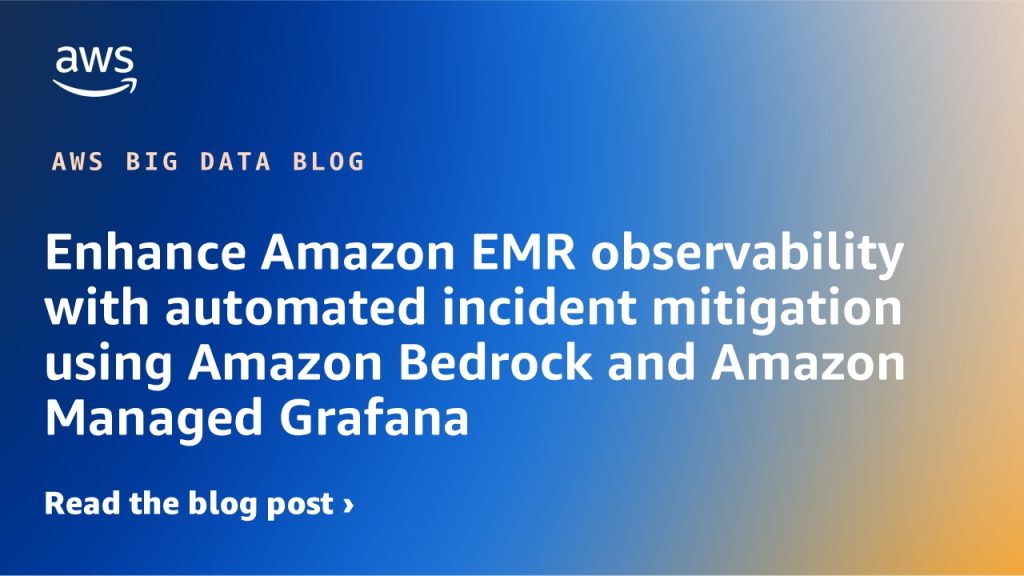AWS Big Data Blog
Category: Amazon Machine Learning
Enhance Amazon EMR observability with automated incident mitigation using Amazon Bedrock and Amazon Managed Grafana
In this post, we demonstrate how to integrate real-time monitoring with AI-powered remediation suggestions, combining Amazon Managed Grafana for visualization, Amazon Bedrock for intelligent response recommendations, and AWS Systems Manager for automated remediation actions on Amazon Web Services (AWS).
Empower financial analytics by creating structured knowledge bases using Amazon Bedrock and Amazon Redshift
In this post, we showcase how financial planners, advisors, or bankers can now ask questions in natural language. These prompts will receive precise data from the customer databases for accounts, investments, loans, and transactions. Amazon Bedrock Knowledge Bases automatically translates these natural language queries into optimized SQL statements, thereby accelerating time to insight, enabling faster discoveries and efficient decision-making.
Improve search results for AI using Amazon OpenSearch Service as a vector database with Amazon Bedrock
In this post, you’ll learn how to use OpenSearch Service and Amazon Bedrock to build AI-powered search and generative AI applications. You’ll learn about how AI-powered search systems employ foundation models (FMs) to capture and search context and meaning across text, images, audio, and video, delivering more accurate results to users. You’ll learn how generative AI systems use these search results to create original responses to questions, supporting interactive conversations between humans and machines.
Enhancing Search Relevancy with Cohere Rerank 3.5 and Amazon OpenSearch Service
In this blog post, we’ll dive into the various scenarios for how Cohere Rerank 3.5 improves search results for best matching 25 (BM25), a keyword-based algorithm that performs lexical search, in addition to semantic search. We will also cover how businesses can significantly improve user experience, increase engagement, and ultimately drive better search outcomes by implementing a reranking pipeline.
Enrich your AWS Glue Data Catalog with generative AI metadata using Amazon Bedrock
By harnessing the capabilities of generative AI, you can automate the generation of comprehensive metadata descriptions for your data assets based on their documentation, enhancing discoverability, understanding, and the overall data governance within your AWS Cloud environment. This post shows you how to enrich your AWS Glue Data Catalog with dynamic metadata using foundation models (FMs) on Amazon Bedrock and your data documentation.
Integrate Amazon Bedrock with Amazon Redshift ML for generative AI applications
Amazon Redshift has enhanced its Redshift ML feature to support integration of large language models (LLMs). As part of these enhancements, Redshift now enables native integration with Amazon Bedrock. This integration enables you to use LLMs from simple SQL commands alongside your data in Amazon Redshift, helping you to build generative AI applications quickly. This powerful combination enables customers to harness the transformative capabilities of LLMs and seamlessly incorporate them into their analytical workflows.
Enriching metadata for accurate text-to-SQL generation for Amazon Athena
In this post, we demonstrate the critical role of metadata in text-to-SQL generation through an example implemented for Amazon Athena using Amazon Bedrock. We discuss the challenges in maintaining the metadata as well as ways to overcome those challenges and enrich the metadata.
Enrich your serverless data lake with Amazon Bedrock
Organizations are collecting and storing vast amounts of structured and unstructured data like reports, whitepapers, and research documents. By consolidating this information, analysts can discover and integrate data from across the organization, creating valuable data products based on a unified dataset. This post shows how to integrate Amazon Bedrock with the AWS Serverless Data Analytics Pipeline architecture using Amazon EventBridge, AWS Step Functions, and AWS Lambda to automate a wide range of data enrichment tasks in a cost-effective and scalable manner.
Enrich, standardize, and translate streaming data in Amazon Redshift with generative AI
Amazon Redshift ML is a feature of Amazon Redshift that enables you to build, train, and deploy machine learning (ML) models directly within the Redshift environment. Now, you can use pretrained publicly available large language models (LLMs) in Amazon SageMaker JumpStart as part of Redshift ML, allowing you to bring the power of LLMs to analytics. You can use pretrained publicly available LLMs from leading providers such as Meta, AI21 Labs, LightOn, Hugging Face, Amazon Alexa, and Cohere as part of your Redshift ML workflows. By integrating with LLMs, Redshift ML can support a wide variety of natural language processing (NLP) use cases on your analytical data, such as text summarization, sentiment analysis, named entity recognition, text generation, language translation, data standardization, data enrichment, and more. Through this feature, the power of generative artificial intelligence (AI) and LLMs is made available to you as simple SQL functions that you can apply on your datasets. The integration is designed to be simple to use and flexible to configure, allowing you to take advantage of the capabilities of advanced ML models within your Redshift data warehouse environment.
Build a real-time streaming generative AI application using Amazon Bedrock, Amazon Managed Service for Apache Flink, and Amazon Kinesis Data Streams
Data streaming enables generative AI to take advantage of real-time data and provide businesses with rapid insights. This post looks at how to integrate generative AI capabilities when implementing a streaming architecture on AWS using managed services such as Managed Service for Apache Flink and Amazon Kinesis Data Streams for processing streaming data and Amazon Bedrock to utilize generative AI capabilities. We include a reference architecture and a step-by-step guide on infrastructure setup and sample code for implementing the solution with the AWS Cloud Development Kit (AWS CDK). You can find the code to try it out yourself on the GitHub repo.









